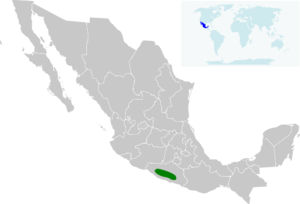Short-crested coquette facts for kids
Quick facts for kids Short-crested coquette |
|
|---|---|
| Conservation status | |
| Scientific classification | |
| Genus: |
Lophornis
|
| Species: |
brachylophus
|
 |
|
| Range of L. brachylophus | |
The short-crested coquette (Lophornis brachylophus) is a tiny, beautiful hummingbird. It is known for its short crest. This bird is very rare. It lives only in a small part of Mexico. Scientists say it is a Critically Endangered species. This means it is in great danger of disappearing forever.
Contents
About Its Name and Family
Scientists give every animal a special name. The short-crested coquette's scientific name is Lophornis brachylophus. It is the only bird of its kind in its group. Sometimes, people thought it might be the same as another bird. That bird is the rufous-crested coquette. But now, they are seen as different species.
What Does the Short-Crested Coquette Look Like?
This hummingbird is about 7 to 7.5 cm (2.8 to 3.0 in) long. That's about the length of your finger! Both male and female birds have a short, straight, black beak.
Male Coquette's Appearance
The adult male has a short, reddish crest on its head. This crest can stand up. The longest feathers on its crest have green tips. Its back is a shiny emerald green. There is a white stripe between its back and its lower rump. The lower rump is a bronzy purple color. The feathers covering its tail are green.
Its throat is a bright, shiny emerald green. Its face has short, orange cheek tufts. These tufts also have green tips. A white band separates its green throat from the rest of its belly. The rest of its belly is a pale cinnamon color. The feathers in the middle of its tail are green. The other tail feathers are reddish cinnamon with black tips.
Female Coquette's Appearance
The adult female looks a bit different. She does not have the crest or the orange cheek patches that the male has. Her forehead is a dull cinnamon color. Her upper body is pale green. There is a buffy or whitish stripe between her back and her dull green rump.
Her throat is whitish. Below her throat is a white band. The rest of her belly is a pale cinnamon color. The feathers in the middle of her tail are green with blackish tips. The other tail feathers are cinnamon. They have a black bar near the end and pale buff tips. Young short-crested coquettes look like the adult female.
Where Does the Short-Crested Coquette Live?
The short-crested coquette lives only in Mexico. Its home is a very small area. It is found along a 25 km (16 mi) stretch of road. This road is in the Sierra Madre del Sur mountains. These mountains are in Guerrero, Mexico. This area is north-west of Acapulco.
This hummingbird likes to live in different kinds of forests. It can be found in forests where some trees lose their leaves. It also lives in humid evergreen forests. These are forests where trees stay green all year. It likes pine-oak forests too. Sometimes, it lives in plantations, which are areas where plants are grown. It lives at heights between 900 and 1,800 m (3,000 and 5,900 ft) above sea level.
Behavior of the Short-Crested Coquette
Movement
Scientists believe the short-crested coquette usually stays in one place. However, it might move up or down the mountains depending on the season.
Feeding Habits
The short-crested coquette eats tiny bugs called arthropods. It also drinks nectar from many small flowering plants. It catches insects by waiting on a branch. When an insect flies by, it quickly flies out to catch it. This is called "hawking." This small hummingbird often lets larger hummingbirds eat first.
Life Cycle and Reproduction
Scientists think the short-crested coquette's breeding season is from November to February. But not much else is known about how these birds raise their young. We don't know about their nests or eggs yet.
Sounds and Calls
The short-crested coquette is mostly a quiet bird. When it is eating, it sometimes makes a high, sharp "sip" or "tsip" sound. It also makes quiet, dry "chi..chi-chi.." sounds. When it hovers in the air, its wings make a low humming sound, like a bee. There are not many recordings of its sounds available.
Why Is This Bird in Danger?
The IUCN (International Union for Conservation of Nature) first said the short-crested coquette was "Endangered." But since the year 2000, they have called it "Critically Endangered." This means it is facing a very high risk of becoming extinct in the wild.
This bird lives in a very small area. None of this area is officially protected. Scientists believe there are fewer than 1000 adult short-crested coquettes left. The biggest threat to this species is the loss of its home. People are clearing land for farming. This destroys the forests where the short-crested coquette lives.


